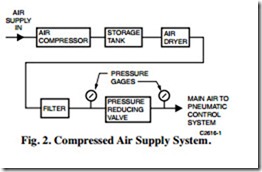AIR SUPPLY AND OPERATION
The main line air supply is provided by an electrically driven compressor pumping air into a storage tank at high pressure (Fig. 2). A pressure switch turns the compressor on and off to maintain the storage tank pressure between fixed limits. The tank stores the air until it is needed by control equipment. The air dryer removes moisture from the air, and the filter removes oil and other impurities. The pressure reducing valve (PRV) typically reduces the pressure to 18 to 22 psi. For two-pressure (day/night) systems and for systems designed to change from direct to reverse acting (heating/cooling), the PRV switches between two pressures, such as 13 and 18 psi. The maximum safe air pressure for most pneumatic controls is 25 psi.
From the PRV, the air flows through the main line to the controller (in Figure 1, a thermostat) and to other controllers or relays in other parts of the system. The controller positions the actuator. The controller receives air from the main line at a constant pressure and modulates that pressure to provide branchline air at a pressure that varies according to changes in the controlled variable, as measured by the sensing element. The controller signal (branchline pressure) is transmitted via the branch line to the controlled device (in Figure 1, a valve actuator). The actuator drives the final control element (valve) to a position proportional to the pressure supplied by the controller.
When the proportional controller changes the air pressure to the actuator, the actuator moves in a direction and distance proportional to the direction and magnitude of the change at the sensing element.
RESTRICTOR
The restrictor is a basic component of a pneumatic control system and is used in all controllers. A restrictor is usually a disc with a small hole inserted into an air line to restrict the amount of airflow. The size of the restrictor varies with the application, but can have a hole as small as 0.003 inches.
